Dr. Phil Zeltzman is a mobile, board-certified surgeon in Allentown, PA. Find him online at www.DrPhilZeltzman.com. He is the co-author of “Walk a Hound, Lose a Pound” (www.WalkaHound.com).
Chris Longenecker, a Certified Veterinary Technician in Reading, PA, contributed to this article.
It is always surprising to me that some clients are not sure of their pet’s diagnosis, or what risks are involved. This is critical, and you should make sure you understand your pet’s condition so you can be better informed and prepared. Here are 10 questions to guide your discussion with your family vet or surgeon.
1. What is my pet’s specific diagnosis?Always ask your family vet or your surgeon for the exact name and spelling of the diagnosis. It is not always easy to understand or remember, so get it in writing. Seriously, who can remember (and spell) “Legg-Perthes disease” (a condition of the hip) or “hepatic microvascular dysplasia” (a liver condition)? If a biopsy has been performed, ask for a copy of the pathologist’s report.
Now, in some cases, we have to be humble and acknowledge that we are simply not sure about the diagnosis. That’s OK as long as you understand the possibilities - good or bad. When thereareseveral possibilities, ask your vet to write them down (legibly).
2. What are the treatment options?
It is important that you understand all of your options when it comes to your pet’s treatment. Vets, whether generalists or specialists, will tend to recommend the best solution in their mind. Most of the time, that’s what you should consider doing.
However, there may be a plan B or C or D. What are those options? Why aren’t they as good?
Some treatments are called “medical” or “conservative.” In the case of a fractured bone, this would mean placing a splint or cast. The opposite is called “surgical” treatment. With a fracture, this could mean repairing the broken bone with a metal plate and some screws. Most of the time, there are fairly clear reasons to choose one versus the other, and you need to understand them.
Another example is a dog with hip dysplasia and arthritis. There are many ways to treat this common condition, medically or surgically. Your vet’s or your surgeon’s job is to discuss each option with you, along with the pros and the cons, so you can make an informed decision.
And if your pet has cancer, you need to understand the risks and benefits of surgery and/or chemotherapy and/or radiation therapy.
3. Complications and Risks
Always ask your vet about possible risks and complications of a particular surgery. Every single procedure has potential risks. No exception. As you can imagine, removing a fatty tumor under the skin doesn’t quite involve the same risks as removing a brain tumor.
If your doctor claims to have no complications, I’m sorry to say… you should run away! An honest, humble vet or surgeon should be willing to explain the risks, both in theory and from personal experience. We may not like talking about complications, but we owe it to you and your pet to discuss risks openly.
We typically describe:
- Minor complications, which include swelling, bruising, and oozing. Those are natural consequences of many surgeries. They come with the territory.
- Serious complications, including opening up of the incision, infection or severe bleeding.
- Catastrophic complications such as complete failure of a surgery.
Anesthesia has its own set of possible complications. Please refer to our blogs on this topic: "5 Questions To Ask Before Anesthesia" and "5 (More) Questions To Ask Before Anesthesia."
4. How many have you done?
Ouch… this is a tricky topic… Young doctors might get offended by this question. To be perfectly honest, I used to feel insulted when clients would ask this question when I was a younger surgeon! Now I know better. It’s a legitimate question.
Don’t be afraid to offend someone. As your pet’s best advocate, you really should know how many similar procedures your doctor has performed. Hopefully, it makes sense that a vet who has done 1,000 spays or 1,000 TPLOs or 1,000 brain surgeries will have more experience and know-how when treating your pet.
5. Prognosis
What is the prognosis or likely outcome of surgery? In the case of cancerous tumors, you need to understand a little bit about statistics. When we say that a patient might live an average of 1 year after removing a specific tumor, what does that mean?
It means that scientific studies looked at say 100 dogs and studied how long they survived. On average, they may have lived 1 year. However, some lived less (2 days) and some lived more (2 years). So please understand that the numbers you hear are only an indication of possible survival. It’s merely an average.
6. How will my pet stay warm during surgery and recovery? When pets are under anesthesia, just like humans, they can quickly get cold, so they need help to stay warm. Warming devices adapted from human hospitals such as fluid warmers, warm water beds and warm air blankets can be used. Ask your vet if they have one or more of these devices to keep your pet warm while under surgery and recovery. This is more important than it might seem, as cold patients recover more slowly and have a higher risk of infection.
When pets are under anesthesia, just like humans, they can quickly get cold, so they need help to stay warm. Warming devices adapted from human hospitals such as fluid warmers, warm water beds and warm air blankets can be used. Ask your vet if they have one or more of these devices to keep your pet warm while under surgery and recovery. This is more important than it might seem, as cold patients recover more slowly and have a higher risk of infection.
7. What happens during the surgery?
Make sure your vet or surgeon explains what is going to happen during surgery. You may or may not want specific or graphic details. You should however understand the general concept. To make sure you understand them, some vets will use pictures from a book. Others will draw their own pictures or use plastic models. If you don’t understand, don’t be embarrassed to say so. Your vet should have no problem repeating the explanation – in a different way.
8. How will my pet’s pain be controlled?
Pain control requirement depends on the procedure your pet is undergoing. Minor procedures may only require one or two injections for pain while at the clinic. Other surgeries may require a much more sophisticated schedule. If your pet is back home after a procedure and seems painful, uncomfortable, restless or anxious, do not hesitate to call your vet and discuss the possibility of adding orchanging the pain medications.
9. Do you have overnight care?
Even though the vast majority of family vets don’t have overnight care, you have the right to know whether your pet will be alone or supervised and by whom. It might be a veterinary technician, or a doctor, or nobody. If you’re not comfortable the lack of overnight care, you may want to talk to your Doctor and explore other options, such as transferring to the local emergency clinic.
If you think that you might be overwhelmed or too emotional, consider having a friend or family member join you. A lot of information will be shared in a small amount of time, so it may be a lot to take in. Don’t hesitate to take notes. Above all, make sure you understand your doctor. I’m sorry to say that I’ve heard colleagues say things like “The purpose of the tibial plateau levelingosteostomy is to neutralize the cranial tibial thrust.” HUH???
10. Post-op care
Your vet or surgeon should give a detailed list of at-home care. This might include a special diet, medications (e.g. pain meds and antibiotics), wound care, exercise restrictions, physical therapy… and the dreaded plastic cone (a.k.a. E. collar).
These instructions are not to punish your pet or make you lose sleep, but to guide you in the right direction to help your pet. When it’s time to go home, a nurse should go over written discharge instructions, item by item: duration of the E collar, duration of confinement, timing of suture removal and bandage changes etc.
Bottom line: your doctor should be able to explain a complicated procedure in simple terms – of course without taking you for a 2 year old. You need to understand what is going to happen before, during and after surgery. This is important. You are your pet’s best advocate.
Phil Zeltzman, DVM, DACVS, CVJ
Dr. Phil Zeltzman is a traveling, board-certified surgeon in Allentown, PA. His website is www.DrPhilZeltzman.com. He is the co-author of “Walk a Hound, Lose a Pound” (www.WalkaHound.com).
If you have any questions or concerns, you should always visit or call your veterinarian – they are your best resource to ensure the health and well-being of your pets
